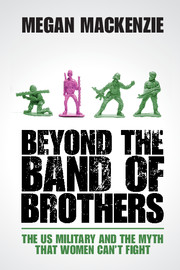Book contents
- Frontmatter
- Dedication
- Contents
- List of tables
- Acknowledgments
- Introduction: myths, men, and policy making
- 1 The combat exclusion is a story we tell ourselves … about men
- 2 The disintegration of the combat exclusion in Iraq and Afghanistan
- 3 It just doesn't feel right: emotion and the combat exclusion policy
- 4 Faster, stronger, more male: women and the failure of physical standards
- 5 Sex, cohesion, and national security
- 6 Using online debates to map public reaction to the combat exclusion
- Conclusion
- Bibliography
- Index
3 - It just doesn't feel right: emotion and the combat exclusion policy
Published online by Cambridge University Press: 05 July 2015
- Frontmatter
- Dedication
- Contents
- List of tables
- Acknowledgments
- Introduction: myths, men, and policy making
- 1 The combat exclusion is a story we tell ourselves … about men
- 2 The disintegration of the combat exclusion in Iraq and Afghanistan
- 3 It just doesn't feel right: emotion and the combat exclusion policy
- 4 Faster, stronger, more male: women and the failure of physical standards
- 5 Sex, cohesion, and national security
- 6 Using online debates to map public reaction to the combat exclusion
- Conclusion
- Bibliography
- Index
Summary
“I just can't get over this feeling of old men ordering young women into combat … I have a gut-based hang-up there. And it doesn't make a lot of sense in every way. I apologize for it.”
Gen. Merrill A. McPeak, former Air Force Chief of StaffThe combat exclusion, like other domestic and foreign policies, tends to be presented as a product of rational decision making based on evidence, experience, and public welfare. This perception leaves little space for thinking about the role of emotion in the making of military policy. This chapter addresses this “emotional gap,” by focusing on the role of emotion within debates on women in combat. I argue that much of the logic used to resist or oppose women in combat has been based either partially or completely on emotion. For example, in the quotation that leads this chapter, General McPeak acknowledges his “gut-based hang-up” regarding women in combat and the possible irrationality of his position. Such reactions raise several questions, including the following: What impact does such visceral, emotional opposition have on military culture, on the debates surrounding women in combat, and eventually, on the process of further integrating women into the US military? What role does the band of brothers myth play in inspiring inherent, inexplicable, or visceral emotional reactions to women in combat? This chapter addresses these questions by exploring the relationship between emotional responses and policies directed toward women in combat.
The chapter does not treat emotion as a problem with regard to policy. Rather, it is argued that overlooking the role of emotion in policy debates obscures a large part of how policies are made, and why they are supported. Emotion matters in the discussion on women in combat for several reasons. First, emotional reactions are common and consistent elements of the debates both leading up to the removal of the combat exclusion and in the aftermath of the policy change.
- Type
- Chapter
- Information
- Beyond the Band of BrothersThe US Military and the Myth that Women Can't Fight, pp. 75 - 97Publisher: Cambridge University PressPrint publication year: 2015



